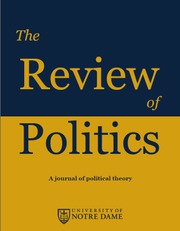No CrossRef data available.
Article contents
Author's Response: New Lines of Sight
Published online by Cambridge University Press: 15 October 2024
Abstract

- Type
- A Symposium on Erin R. Pineda's Seeing Like an Activist: Civil Disobedience and the Civil Rights Movement
- Information
- Copyright
- Copyright © The Author(s), 2024. Published by Cambridge University Press on behalf of University of Notre Dame
References
1 Bedau, Hugo A., “On Civil Disobedience,” Journal of Philosophy 58, no. 21 (October 1961): 654CrossRefGoogle Scholar.
2 Center for Popular Democracy, Law for Black Lives, and Black Youth Project 100, Freedom to Thrive: Reimagining Safety and Security in our Community (July 4, 2017), 3–4.
3 Berger, Dan, Captive Nation: Black Prison Organizing in the Civil Rights Era (Chapel Hill: University of North Carolina Press, 2014), 46Google Scholar.
4 Bell, Joyce M., “Kangaroo Court: The Black Power Movement and the Courtroom as a Space of Resistance,” American Behavioral Scientist 66, no. 11 (2022): 1551CrossRefGoogle Scholar.
5 Berger, Captive Nation, 46–47. Carmichael's speech is often, though erroneously, referenced as the origin of Black Power as both slogan and movement.
6 Haywood Burns, “Can a Black Man Get a Fair Trial in this Country?,” New York Times Magazine, July 12, 1970, 46. Burns was founder and first executive director for the National Conference of Black Lawyers, which was meant to serve as “the legal arm of the movement for Black liberation.” See https://www.ncbl.org.
7 Rawls, John, A Theory of Justice, rev. ed. (Cambridge, MA: Belknap Press of Harvard University Press, 1999), 322CrossRefGoogle Scholar.
8 See, e.g., Hussein, Nasser, The Jurisprudence of Emergency: Colonialism and the Rule of Law (Ann Arbor: University of Michigan Press, 2003)CrossRefGoogle Scholar; Rana, Aziz, The Two Faces of American Freedom (Cambridge, MA: Harvard University Press, 2014)CrossRefGoogle Scholar.
9 Schrader, Stuart, Badges without Borders: How Global Counterinsurgency Transformed American Policing (Oakland: University of California Press, 2019), 19–20 (emphasis added)Google Scholar.
10 Ibid., 24.
11 Erin R. Pineda, “The Mississippi Runs into the Mekong: The Internal Colony's Recursions and Collisions” (unpublished manuscript).
12 Passavant, Paul A., Policing Protest: The Post-democratic State and the Figure of Black Insurrection (Durham, NC: Duke University Press, 2021)Google Scholar.
13 Akbar, Amna, “Toward a Radical Imagination of Law,” New York University Law Review 93 (June 2018): 479Google Scholar.
14 Akbar, Amna A., Ashar, Sameer M. & Simonson, Jocelyn, “Movement Law,” Stanford Law Review 73 (April 2021): 844Google Scholar. I see Akbar et al.'s call for the development of “movement law” as akin to what it might mean to “see like an activist” within political theory.


